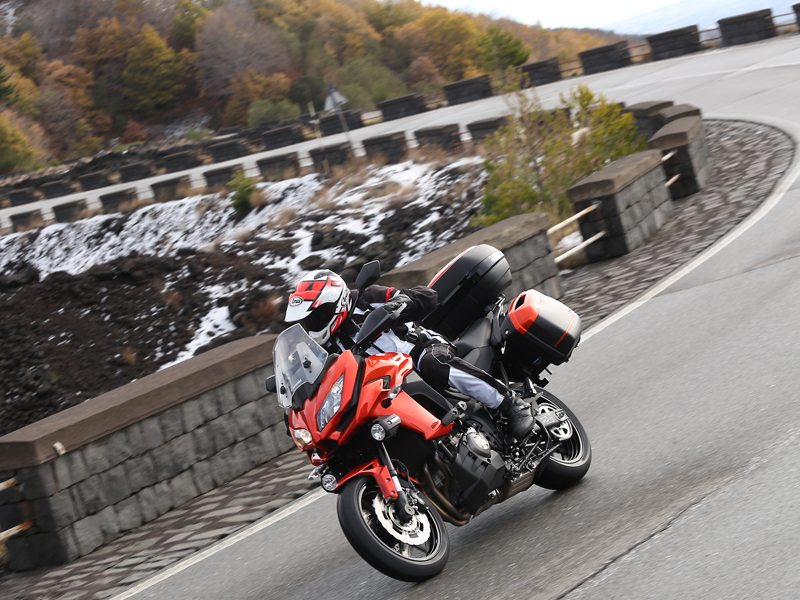
Using the same engine in multiple motorcycle models makes good economic sense. The 649cc parallel twin that debuted in the Kawasaki Ninja 650 found its way into the Versys 650 (read our review of the 2015 Kawasaki Versys 650 LT) and the new Vulcan S cruiser. Likewise, the 1,043cc in-line four in Kawasaki’s Z1000 and Ninja 1000 powers the new Versys 1000 LT, a street-focused adventure tourer that makes its U.S. debut for 2015. In previous tests, we praised the liter-plus engine for its smooth, generous power, maxing out at 127 horsepower and 76 lb-ft of torque on Jett Tuning’s dyno, and it suits the Versys 1000 to a T, with spot-on throttle response and torque as broad as the horizon.
Read our 2014 Kawasaki Ninja 1000 ABS review
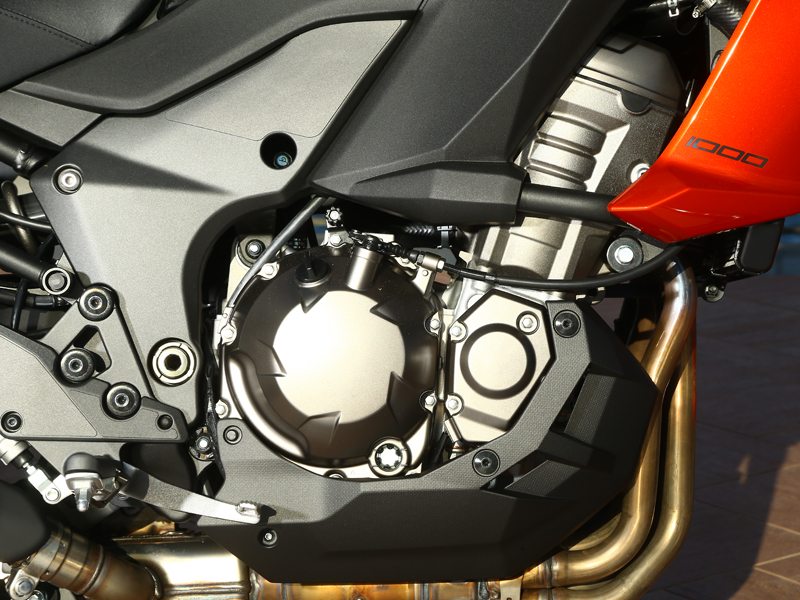
The liquid-cooled, DOHC, 4-valves-per-cylinder engine inhales fuel through four 38mm Keihin throttle bodies with oval sub-throttles, and exhales spent gasses pass through four interconnected headers and an under-engine pre-chamber before exiting through a single silencer, foregoing the quad pipes found on the Z1000 and Ninja 1000. Power is transmitted to the rear contact patch through a cable-actuated Assist and Slipper Clutch, 6-speed transmission and O-ring chain. Two power modes, Full (100 percent) and Low (75 percent), and Kawasaki Traction Control (KTRC), with three modes plus Off, provide flexibility and a valuable safety net.
The Ninja 1000 sportbike was designed for the real world, with usable performance, reasonable ergonomics and optional saddlebags. The Versys 1000 offers the same level of performance in an even more touring-ready package, with better wind protection, more comfort and ample passenger accommodations, along with standard saddlebags, a luggage rack, hand guards and a centerstand. Like its sportbike brethren, the Versys is built around a stout twin-spar cast aluminum frame that uses the engine as a stressed member, with two of the four engine mounts made of rubber to reduce vibration. A heavy-duty subframe handles the weight of a passenger and 28-liter Kawasaki Quick Release saddlebags loaded with gear. The color-matched, Givi-made bags are able to swallow a full-face helmet in either side and they’re keyed to the ignition. The bikes we tested were fitted with factory accessories, including a 47-liter top case ($582.75), grip heaters ($289.95), a gear position indicator ($206.95), LED lights ($514.95) and frame sliders ($279.95). Many other accessories will be available, including a larger windscreen, gel seat and 12V socket.
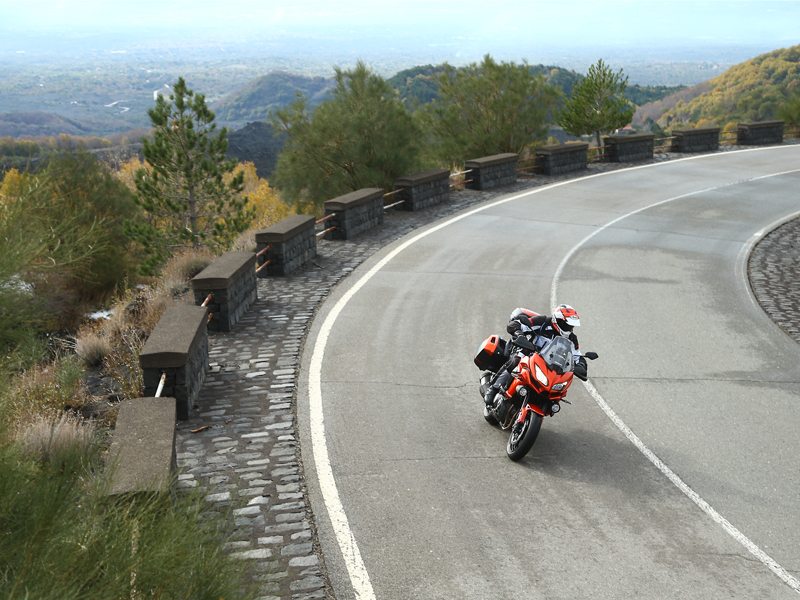
Kawasaki co-launched the Versys 1000 LT and Versys 650 LT on Sicily, perched less than two miles from the toe of Italy’s boot. Rising steeply out of the sea, the volcanic island is crisscrossed by a tight maze of roads built and rebuilt over thousands of years. After negotiating an obstacle course of traffic-choked streets and roundabouts, we ascended the south face of 10,990-foot Mount Etna, a snowcapped, lava-spewing volcano. The higher we went, the wetter the pavement became and soon ice was visible along the road’s edge. Because the Versys doles out power smoothly, handles predictably and wears good Bridgestone Battlax T30 sport-touring tires, I took the sketchy conditions in stride.
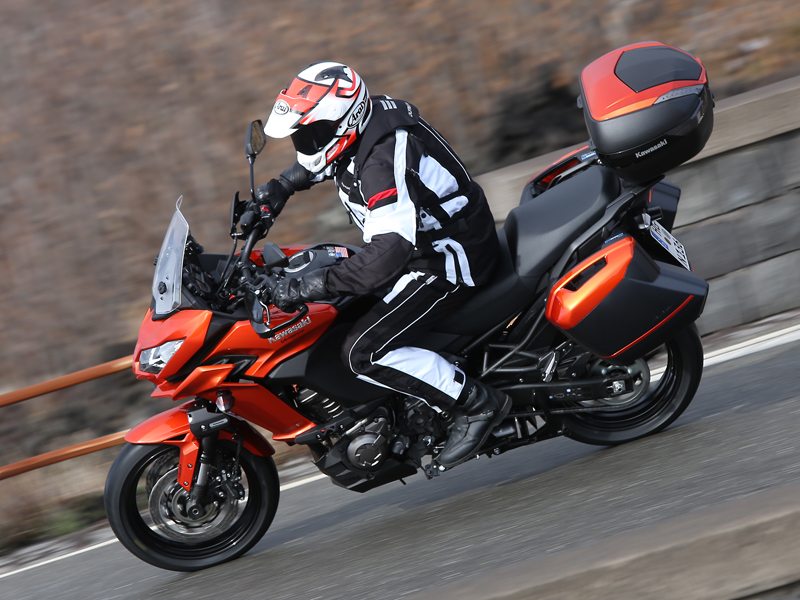
Although not as agile as its lighter, shorter 650 stablemate, the Versys 1000 is a surefooted corner carver nonetheless. Today’s tall adventure bikes, with their upright riding positions and high, wide handlebars, make it easy on riders. Stay relaxed, put a little pressure on one grip or the other, and dive into or climb out of corners with ease. The Versys’ 17-inch front wheel helps it change directions more easily than similarly sized adventure bikes with 19-inch fronts, yet it remains perfectly calm in the high seas of speed. Road-hugging help comes courtesy of KYB suspension with 5.9 inches of travel front and rear, which absorbed Sicily’s worst road conditions without complaint and provided a plush, well-controlled ride. The 43mm inverted fork’s long outer tubes reduce flex, and its rebound and compression dampers have special valves to provide consistent damping performance when the fork changes direction. Both the fork and horizontal back-link shock are adjustable for rebound and spring preload (via a remote knob on the shock). Triple-disc Tokico brakes, with a pair of four-piston calipers gripping 310mm petal-style rotors up front and a single-piston caliper gripping a 250mm petal-style rotor out back, provide ample stopping power, and ABS is standard.
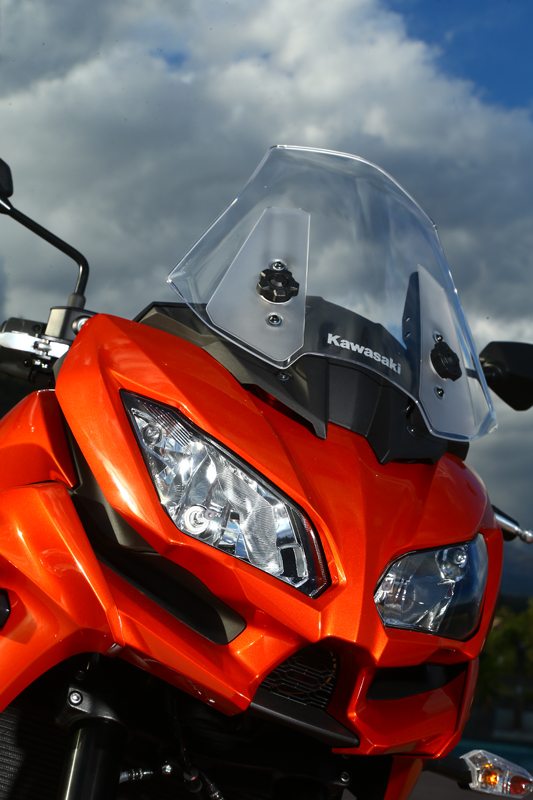
The Versys 650 and 1000 share the same Ninja-like styling, with a sharp-edged upper fairing that features twin cat-eye headlights, a chin spoiler for stability and side channels for better airflow. Two knobs on the front of the windscreen allow it to be moved up or down over a 3-inch range. Wind protection is good, on par with other adventure bikes, but less than that of full-boat sport tourers such as Kawasaki’s Concours 14. Rugged-looking instrumentation features an analog tach and an LCD display with speed, fuel level, clock and other functions. Two color choices are available, Candy Burnt Orange or Flat Ebony, both with Metallic Spark Black on the steel fuel tank.
The Versys 1000 LT is a welcome addition to the touring market, blending impressive performance with practicality and good value. It is well suited to any type of riding, from daily commuting to long-distance, two-up touring and everything in between. During our last Ninja 1000 test we averaged 37 mpg, and similar fuel economy would yield just over 200 miles from the Versys’ 5.5-gallon tank. Putting it in Low power mode and relaxing the throttle to keep the ECO indicator illuminated will further extend range. Power, weight (549 pounds wet, claimed) and seat height (33.1 inches) are similar to that of other liter-class adventure tourers, but the Versys’ $12,799 base price is well below that of most of the competition, even before factoring in the standard hard saddlebags. We’ll soon start testing the Versys 1000 LT on home turf, and we’ll have comparison test with the Suzuki V-Strom 1000 soon.
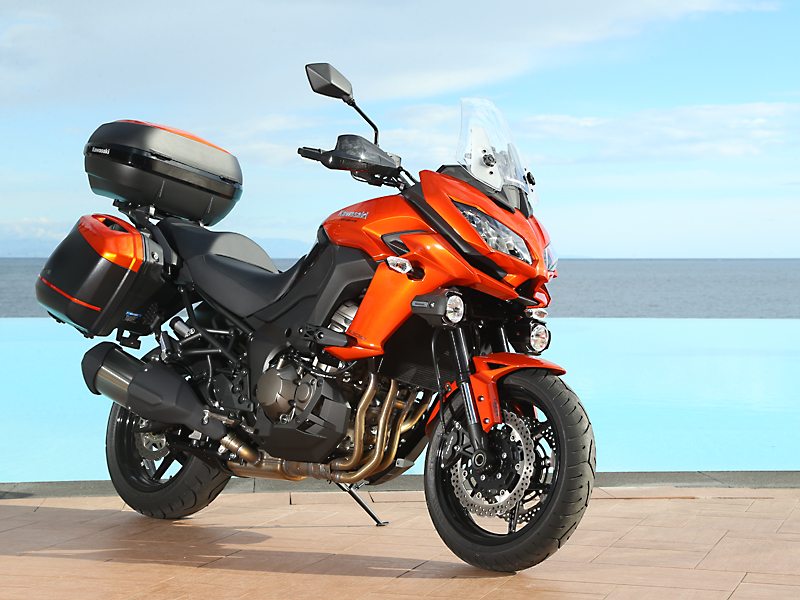
Rider selected the Kawasaki Versys 1000 LT as 2015 Motorcycle of the Year
Read our 2015 Kawasaki Versys 1000 LT long-term review
2015 Kawasaki Versys 1000 LT Specs
Website: kawasaki.com
Base Price: $12,799
Price as Tested: $14,674 (top case, grip heaters, gear position indicator, LED lights, frame sliders)
Engine Type: Liquid-cooled, transverse in-line four, DOHC, 4 valves per cyl.
Displacement: 1,043cc
Bore x Stroke: 77.0 x 56.0mm
Transmission: 6-speed, cable-actuated wet clutch
Final Drive: O-ring chain
Wheelbase: 59.8 in.
Rake/Trail: 27 degrees/4.0 in.
Seat Height: 33.1 in.
Claimed Wet Weight: 549 lbs. (without accessories)
Fuel Capacity: 5.5 gals.
MPG: NA

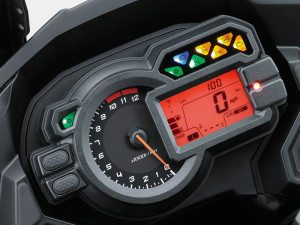
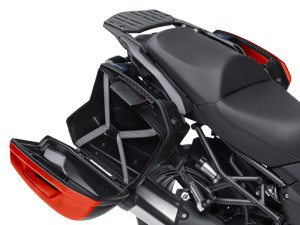
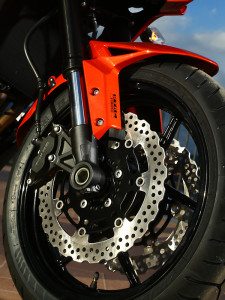
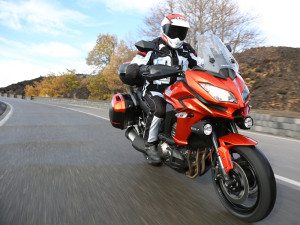
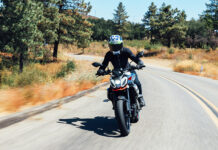
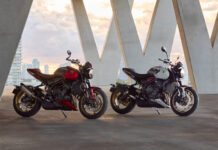

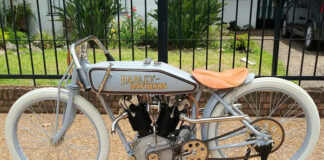
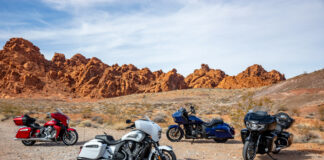


Hey Rider,
When you do that comparo test between the Versys 1000 and the V-Strom 1000 could you please include the new Triumph Tiger and the Yamaha FJ-09?
Again another street bike with more suspension travel than necessary contributing to a seat height over 33 inches. Style is important but why not leave form over function to Harley Davidson.
I love the seat height. Fits me perfectly. This seat height forces me to sit in a position that is better for my back when on longer trips.. I also prefer riding higher off the road rather than closer to it. There are plenty of bikes with low seat heights on the market. THe lower the seat height the more I tend to slouch which is painful when riding over 200 miles. The average height of an american male between the ages of 20 and 29 is 5 feet 10 inches. I am just over 6 feet tall (not quite 6’1″) and the versys is perfect for me. For the average person, all they would need to do is buy an after market seat which can lower this bike as much as 4 inches from what I read. Anyways, I understand the frustration you are having with the seat height but I am thankful for it.
Another great motorcycle that 2/3’s of American riders
can’t ride. Stupid,yes stupid seat heights again and again.
High center’s of gravity than all the Harley Line up.
Another Harley for us come warmer weather.
I have been on both Harley’s and Kawasaki’s motorcycles. Higher centers of gravity is a style of bike that a lot of people prefer over the lower centers of gravity you find on many cruisers. In my opinion, I have never ridden a Harley that is near as fun as the Kawasaki Versys 650. I was set to purchase the 2015 Versys 1000 and enjoyed my ride on the 650 versys so much that i decided to purchase the 650. Of course, this is just one riders opinion. Millions of people prefer Harleys and I respect that but there is a market for those of us preferring the higher centers of gravity. I have found that most people buy and ride Harleys because their neighbors have them and not because they are more comfortable. I can go online right now and find Harley that are ten years old with only 5 of 6 thousand miles on them. This tells me there is a lot of buyers remorse out there. I commute to work everyday on my bike and take weekend excursions from time to time. I have never been uncomfortable on the versys.
No, not stupid, why tall people should have legs bent
Tall bikes for tall people, small bikes for small people, no pb
Why can’t 2/3rds of Americans ride this bike? I am a genuinely completely mystified 6 foot Brit….. Have a test ride booked on this machine later in the week, having fallen out of love a bit with my V-Strom, which is utterly brilliant except for dreadful low rev engine control which has finally driven me nuts.
I have a 30″ inseam and can flat foot on this bike with no problem. I like this bike from what I’ve seen of it in the showroom but I don’t like the way Kawasaki charges extra for options that should be standard on this bike. And if the engine’s so torquey and has such a wide powerband, why the six-speed transmission instead of five?